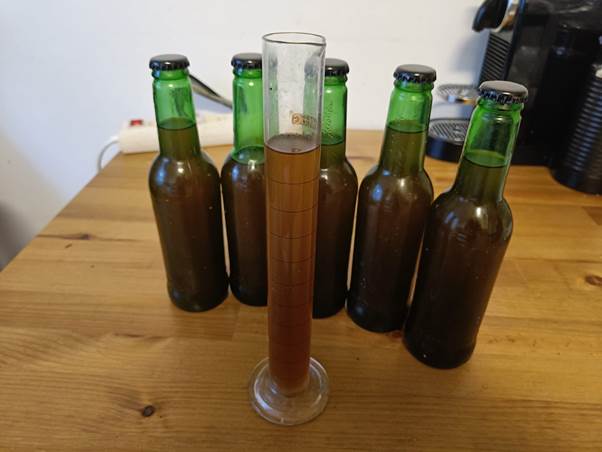

There is an old Sumerian proverb that roughly translates to: "He who does not know beer, does not know what is good." Which is not too surprising, as beer was a major dietary staple of the Mesopotamian culture, with some texts suggesting that Babylon alone had over 70 varieties of beer. This quote and many other texts about ancient beers have spiked my interest whenever I read about them, as I like trying out new (and old!) brewing recipes to see how tastes evolved over time. especially the very rough recipe that has survived.
When it comes to making Sumerian beer, we are both lucky and unlucky. Lucky because historians have learned a lot about the spices, grains, and general cuisine of the time by means of old tablets and content analysis of old clay jars. There even is a preserved tablet containing a beer recipe, the oldest in the world! The unlucky part is that the Sumerians were not very precise in their writing, omitting quantities and most methods of preparation, leaving only some relatively vague instructions in the form of a 4000 year old prayer called the "Hymn to Ninkasi". Additionally, we are unlucky because historians are (typically) not brewers and unfortunately tend to misinterpret the recipes in ways that most homebrewers can point out. For example in Kaufman's "Cooking in Ancient Civilizations", we are told to 'ferment' unmashed grains in room temperature water for 2 days, which is too cold to convert any of the starches to sugars. Also in a video by the British Museum they brew a nicely interpreted brew in a small vessel without keeping it hot, effectively skipping the mash again. It seems like the person instructing them did do it properly, since the bottled beer tasted good, but do watch out if you want to follow that video.
Of course, there are exceptions to this rule, with both historians and interested people (like myself) reinterpreting the recipes in different ways. E.g. The world that was, the Sumerian beer project, BYO.com (and another), Maltose Falcons, Beer by the Number, Micahjoel, Netplaves, The past is a foreign pantry, and Hvitr. Interestingly none of these recipes are the same and result in very different beers. Most use a type of bread as a fermentation base, that's where the similarities stop. Now, I'd like to add to this list by presenting my own interpetation of the Hym to Ninkasi, which I have come up with after about 2 years of experimentations. It is somewhat close to Hvitr's recipe, but still different enough to discuss. The resulting beer is an interesting beverage not too unlike Russian bread kvass and vaguely reminiscent of coffee when drunk at room temperature.
The hym to Ninkasi is both a prayer and a manual. Probably something that the brewers would sing while preparing the beer in order to remember the steps. The first 12 lines are mainly just praise to the beer goddess, but after that we get the following:
You are the one who handles the dough [and] with a big shovel, mixing in a pit, the bappir with sweet aromatics. It is you who bake the bappir in the big oven, and put in order the piles of hulled grain. (I'm skipping all repeated lines.)
This step tells us to make a seasoned bread out of either barley grain or malt. It should also be a dry bread, as the Sumerians would store it in warehouses for months. Some of the recipes seem to ignore this fact and instead make a sort of sourdough by placing their yeasted barley dough in the oven for about 15 minutes to get a crust while keeping the insides raw. Several days later this dough will look and smell very differently, but also make a very sour tasting brew. For this reason and to stick to the idea of storing the bread, I have used the following recipe.
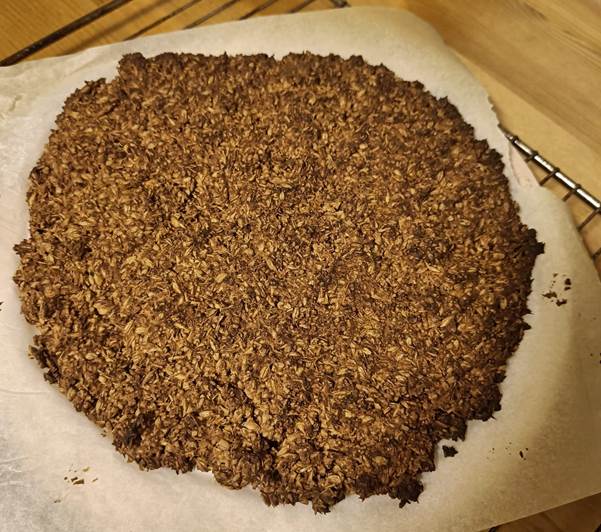
Enough for 2 batches
Mix all ingredients except for the water and flower in a large enough container until they are mixed evenly. This will not stick together at all, which is why you will need about 1-2 Tbs of flour and some water. After adding these you should get a thick sticky substance that sort of sticks together. Spread this out on a baking sheet or pizza stone (I suggest with baking paper under it) and create a pancake of about 1 cm thick. Then bake it at 180 degrees Celsius for 30 minutes.
The resulting bread should smell very malty and be much more solid. Try to make it as dark as possible, even potentially allowing the edges to burn a bit as burnt bread is a good bittering agent to replace the lack of hops. Either way, this is where most of your taste will come from.
Now cut the bread into small chunks while it is hot and then let it cool. After that, put it into a 50 degree oven and leave it for a few hours up to overnight. You should be left with a very dry and slightly darkened 'bread' that kind of looks like modern energy bars and can be eaten as such given the sugar and malt content.
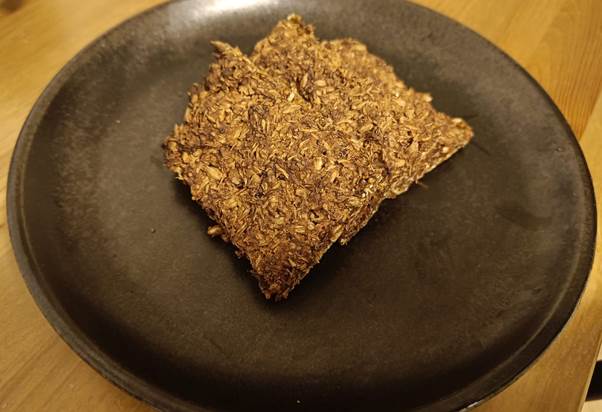
Continuing with the Hym, we find that line 21 to 32 tell us how to turn grain into malt. Basically by leaving it in water and then dry it while your noble dogs are guarding the grain from everyone, even corrupted rulers! We skip this step because we bought malted grains, as that saves a lot of hassle.
We then get line 33-40:
It is you who hold with both hands the great sweetwort, brewing it with (date) honey and wine. (line damaged) You ...... the sweetwort to the vessel.
These lines have been interpreted in many ways, especially because honey can mean both honey and date syrup and wine can mean both wine, raisins, and grapes! Regardless, this is where the yeast comes in. Either via the wine or from the skins of the raisins or grapes. I simply replaced it with yeast, just to have some more control over the mixture.
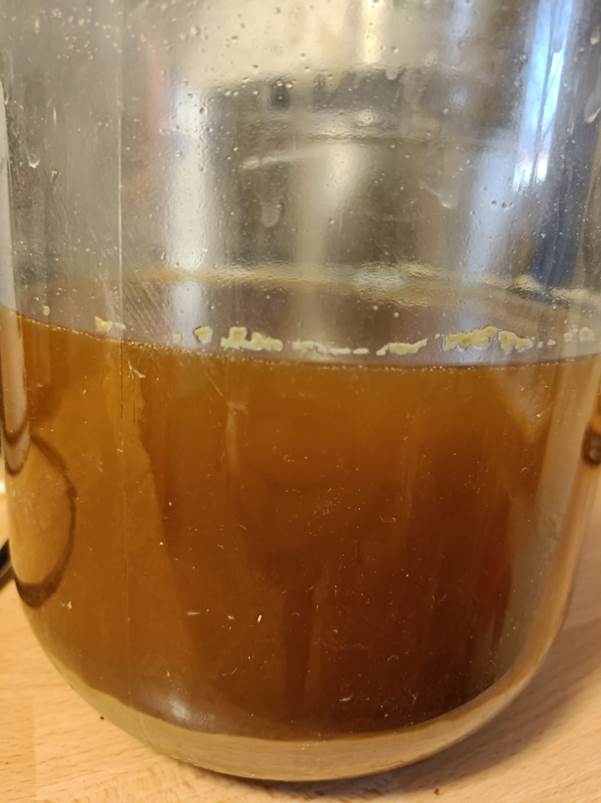
Place the bappir and malt into a pan with 3L of water (I placed it into a muslin bag for easy cleaning) and mash at 70 degrees for about 30-40 minutes while stirring occasionally. Then lower the temperature to 60 degrees for about 20 more minutes. Add 1 or 2 TBS of date syrup, depending on how strong you want the alcohol to be.
This mashing process roughly approximates putting grain into a gigantic clay pot filled with hot water that cools over the course of a few hours. If you have a hydrometer, then you can check the gravity, which should be around 1.060, which will result in a roughly 5-6% beer.
We continue looking at the hym, now at line 41-44:
You place the fermenting vat, which makes a pleasant sound, appropriately on top of a large collector vat.
Pour the (still hot) mixture into a 1 gallon fermenting vessel and top off to get the full amount. I suggest that you pour the mixture through a cloth or some kind of filter to get rid of all the malt and bappir bits. The Sumerians of course did not do this, but unless you want to drink the beer through a straw like the Sumerians did, I can suggest giving up this bit of authenticity for convenience.
We let the wort cool down naturally, which means that you have to make sure that nothing bad comes into the fermentation vessel during this process. I just close it off with the bubbler, which will bubble in reverse for a bit as the water vapor condenses back into water. Then once you think the wort is cool enough (typically 3-4 hours later) you pitch the yeast. I used Voss Kveik yeast, because that is what I had. (Don't forget to clean the fermenter before use!)
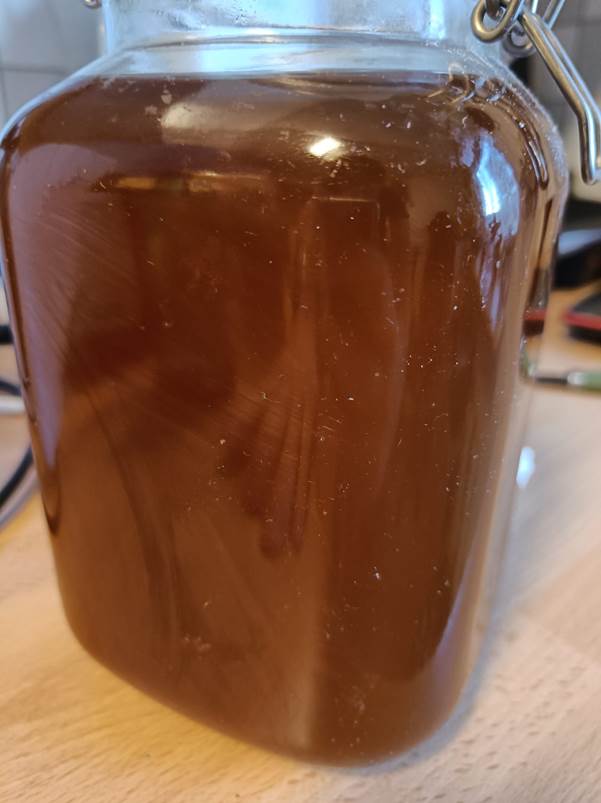
The fermentation took me 3 days, but it will probably be slower with other yeasts. Either way, I suggest putting the brew into the fridge once fermentation is complete so that most of the active yeast can go dormant and fall to the bottom. This again is not a mandatory step, but some people get 'digestive problems' when they ingest too much active yeast at once. Normal beer has less of an issue in this extent, because you age it in a bottle, while this is meant to drink fresh, at room temperature and mostly flat. Of course, you can bottle it, and then it will carbonate like any beer, but don't keep it too long or it might go bad. Either way, you are ready to drink your Sumerian beer! The hym also agrees, as the last few lines of the hym read the following.
It is you who pour out the filtered beer of the collector vat; it is like the onrush of the Tigris and the Euphrates.
Maybe don't let it flow as hard as the two largest rivers of Sumeria, but do enjoy your drink! how does it taste? Quite good! Very different from tranditional beer and closer to Russian kvass (which makes sense, as that is also bread and malt based), but also a bit like a weak coffee. I never really had something like this though, so I would suggest you try. :) I'd also love to hear if you decide to make this and what changes you end up making to the recipe. Feel free to send me an email, etc.